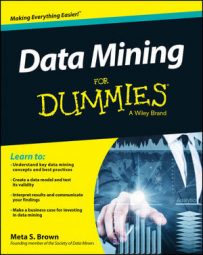You’re not getting into data mining just for the fun of playing with numbers. You want action. You want to see things done right, and you understand that it’s important to base business decisions on solid evidence from data.
But you’re not the one with the power to make the decisions. So you’ll need to exercise your influence with the people who have authority. Don’t expect them to learn your language; it’s up to you to learn theirs.
And it’s not enough to just speak in plain language. You also have to appreciate the executive’s feelings. Executives don’t win their jobs in a lottery. They fight for them. They are driven to rise to executive roles because they are people who need to feel
Important
Confident
Powerful
So you must play to those elements of the executive personality.
Consider these four principles for talking data mining with executives:
The only numbers that interest executives are numbers with dollar signs in front. (Pounds, yen, euros, and so on are also acceptable.)
Don’t mention model fit measures, sensitivity analysis, significance, or any other data-mining technical term when presenting to an executive. Use plain words, and explain everything you possibly can in terms of money:
Bad: “I’ve developed a stable model with optimized parameters for scoring customer credit records. The pseudo r-squared is 0.5519, and the p values for the input variables are all less than 0.02.”
Why is it bad to use technical language? Your executive won’t fully understand it and won’t feel confident. Your message won’t sound like a solid basis for taking action.
Good: “We can identify an additional 2 percent of the customer database who meet our acceptable loan risk criteria, offering a potential of $2 million in added revenue for next fiscal year.”
Now you’re speaking in language that the executive fully understands! This inspires confidence.
Executives have very short attention spans: Get to the point.
The most effective way to get an executive to make time for you and your message is to assume that the executive won’t have time for you. Sound backward? Having many people competing for time and being free to choose the most interesting and compelling activities make the executive feel important. Compel the executive to linger with you by offering a compelling message quickly.
Imagine that the executive will have only 60 seconds to spend with you. What would you say? Just the things you care about most, right? And the most compelling reasons to believe you. If you had five minutes, you’d add more information, but still it would be carefully selected.
Plan your presentation with this in mind. Open with 60 seconds of the most important and convincing thoughts you have to offer. Then briefly add a little detail. Be prepared to continue in steps. Stop to answer questions. Know your material well and be prepared to change the sequence or to go into more or less detail in response to the executive’s interest.
Beware of details.
You’ll find two types of executives: those who have no interest in details and those who have far too much interest in details. The first type is easily bored; if you provide too much detail, you’ll lose that executive’s interest entirely. The second is easily sidetracked; the executive may take notice of something small and become strongly engaged, just not in the point you are trying to make.
Keep your presentations, and especially your visuals, spare and simple. Focus on the point you are making and the information that supports it.
Don’t introduce distracting details. If you are trying to make a point based on the behavior of 90 percent of shoppers, don’t display a huge scatterplot that includes 100 percent of the shoppers on the screen behind you. Choose another type of image, one that won’t draw attention to outliers and extremes and distract from your point.
Striptease holds attention better than full disclosure.
Nothing makes an executive feel more powerful than discovery. The executive wants to feel clever, even brilliant. He’ll get no thrill in witnessing an information dump. Reveal only a little at first and let your executive feel powerful by asking questions and treating the responses as discoveries.
As you plan your layered presentation, build in opportunities for the executive to ask questions. You have anticipated the questions, created the paths that lead to the questions, prepared responses to the questions (in fact, you desire these questions), and you know the responses will lead the executive to the conclusion you have in mind. But never, ever reveal your plan.
Asking open-ended questions and having them answered enable the executive to draw conclusions, conclusions that are the executive’s alone. You know that your presentation has guided the executive to the only reasonable choice, but keep that your little secret. Let the executive feel important, confident, and above all, powerful.

